|
|
ARTHROPODS:
Insects»
Spiders»
Centipedes»
Millipedes»
Sowbugs»
Harvestmen»
Mites
& Ticks»
Scorpions»
Identification
Tips»
About
the Critter Files»
Links» |
|
|
|
 |
PLANT
BUGS
(AKA
"LEAF BUGS")
Critter
Files/Insects/True
Bugs/Plant Bugs
By Blake Newton
University of Kentucky Department of Entomology |
| |
|
| Common
Kentucky Plant Bugs: |
| |
| TAXONOMY |
KINGDOM:
Animalia | PHYLUM: Arthropoda | CLASS: Insecta | ORDER: Hemiptera
| FAMILY: Miridae (plant or leaf bugs) |
| |
| Other
Names: Leaf Bugs, Mirids |
| |
WHAT
IS A PLANT BUG?
LIFE CYCLE
ECOLOGY
PEST STATUS
COMMON KENTUCKY PLANT BUGS
COMMON
KENTUCKY SCENTLESS PLANT BUGS
COLLECTING & PHOTOGRAPHY
PLANT BUG FACTS
MYTHS, LEGENDS, AND FOLKLORE |
| |
| WHAT
IS A PLANT BUG? |
|
| Plant
Bugs, also called "Leaf Bugs,"
belong to the family Miridae, the largest family in the order Hemiptera
(which also includes Stink Bugs,
Leaf-footed Bugs, and Assassin
Bugs). All insects in Hemiptera share a few characteristics,
including piercing-and-sucking mouthparts and wings (called hemielytra)
which are membranous at the tips but hardened at the base. Plant
bugs can be difficult to distinguish from other Hemiptera, especially
Leaf-Footed Bugs and certain Stink Bugs. However, plant bugs,
at less than 3/8" (1 cm), are usually smaller than similar hemipterans.
Plus, plant bugs lack ocelli (the small, simple eyes that appear
on many insects) and have 2 closed cells in the membranous portion
of their hemielytra (shown below). |
| |
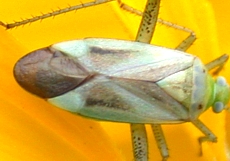
Plant Bug: roll mouse over picture to see the
2 closed cells in hemielytra (B. Newton, 2003)
|
|
| SIZE:
Up to 3/8" |
| |
| LIFE
CYCLE |
|
Like
all Hemiptera, plant bugs go through a simple metamorphosis with
egg, nymph, and adult stages. Females of most species use
a knife-like ovipositor to insert eggs into plant stems or leaves.
After hatching, the wingless nymphs (which resemble small,
wingless adults) molt several times before becoming full-sized,
winged adults. The adults will often mate and reproduce numerous
times during late spring, summer, and early fall. Large nymphs
or adults are usually the overwintering stage. |
| |
 Plant
Bug Nymph, Neurocolpus nubilus (B. Newton, 2003)
Plant
Bug Nymph, Neurocolpus nubilus (B. Newton, 2003) |
| |
| ECOLOGY |
|
| |
There are
many plant bug species in Kentucky. The majority are herbivores,
and use their piercing-and-sucking mouthparts to feed on plant juices.
Most herbivorous species feed on a variety of plants, including
crop and garden species. A few species of plant bugs are predatory,
and they are similar in behavior to assassin
bugs and damsel bugs. Some
species are important predators of whitefly pests on vegetable crops.
Like stink
bugs and many other hemipterans, plant bugs are able to secrete
foul-smelling, foul-tasting fluids from pores on the sides of their
bodies. These secretions help to protect plant bugs from predators.
Plus, many species are camouflaged with brown, green, and
gray markings. Even with these defenses, plant bugs are often
eaten by birds, spiders, assassin bugs, and other predators. |
| PEST
STATUS |
|
There are
dozens of plant bug species in Kentucky, and most of them are not
pests. There are a few species, though, that can sometimes
cause problems in field crops, gardens, and on landscape plants,
including the Four-Lined Plant Bug and the Tarnished
Plant Bug, discussed below. These bugs cause damage by
sucking juices from plants, which causes leaves to discolor and
shrivel. Read more about these pests in our online factsheet:
Plant
Bugs and Lace Bugs.
|
| |
| |
| COMMON
KENTUCKY PLANT BUGS |
|
|
FOUR-LINED
PLANT BUG
GENUS and SPECIES:
Poecilocapsus lineatus
The Four -Lined
Plant Bug, Poecilocapsus lineatus, is one of Kentucky's
most distinctive plant bug species, with bold black and yellow stripes.
Adults are about 3/8" long. This species is common
in a variety of habitats, including gardens, crops, and meadows.
It appears in May and June in Kentucky, occasionally damaging
landscape plants like currant, rose, forsythia, sumac, viburnum
and fruits and herbs grown in gardens.
|
| |
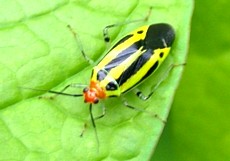 Four-Lined
Plant Bug (B. Newton, 2004)
Four-Lined
Plant Bug (B. Newton, 2004) |
|
|
|
TARNISHED
PLANT BUG
GENUS and SPECIES:
Lygus lineolaris
The Tarnished
Plant Bug, Lygus lineolaris, is named for its
appearance, which resembles tarnished metal. Adults are about
3/8" long. This bug is common throughout the late spring,
summer, and fall in Kentucky, and is sometimes a serious pest of
garden plants and alfalfa. |
| |
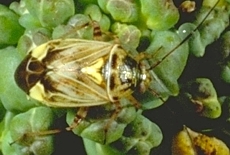 Tarnished
Plant Bug (R. Bessin, 2002)
Tarnished
Plant Bug (R. Bessin, 2002) |
|
|
|
CLOUDED
PLANT BUG
GENUS and SPECIES:
Neurocolpus nubilus
The Clouded Plant
Bug, Neurocolpus nubilus (1/4" long), is
common in Kentucky, and is sometimes a pest on landscape plants
(its nymph is pictured in the Life Cycle section
above). |
| |
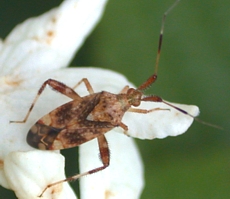 Clouded
Plant Bug (B. Newton, 2003)
Clouded
Plant Bug (B. Newton, 2003) |
|
|
|
Hyaliodes
vitripennis
GENUS
and SPECIES: Hyaliodes
vitripennis
Hyaliodes vitripennis
(3/16" long) is one of the few predatory plant bugs in Kentucky.
It feeds on mites in many tree species, including orchard trees.
It has partially transparent wings, an unusual feature among
plant bugs. |
| |
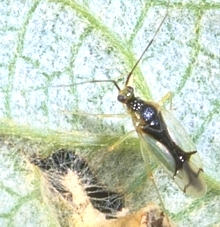 Hyaliodes
vitripennis (R. Bessin, 2002)
Hyaliodes
vitripennis (R. Bessin, 2002) |
|
|
|
Other
Plant and Leaf Bugs
In addition to the species
pictured above, there are many common plant and leaf bugs in Kentucky.
Unfortunately, little is known about most of them. Pictured
below are some common species. |
| |
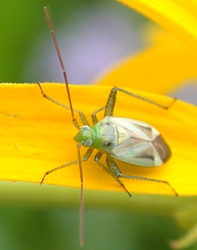 Calocoris
sp.
Calocoris
sp.
(B. Newton, 2003) |
 Unknown
species (possibly Stenodema)
Unknown
species (possibly Stenodema)
(B. Newton, 2003) |
|
| |
| COLLECTING
& PHOTOGRAPHY |
|
Plant bugs
are very common, and can be found on spring, summer, and fall days
in gardens, crops, weeds, trees, and other vegetation. In
particular, four-lined plant bugs and tarnished plant bugs are very
commonly found in gardens and meadows.
Some plant bugs have
unique appearances and vibrant colors, and make nice photo subjects
or additions to an insect collection. Like many Hemiptera,
plant bugs are normally slow moving and are commonly found resting
on leaves and flowers, so they are easy to capture and photograph.
|
| |
| PLANT
BUG FACTS |
|
With several thousand
species worldwide, there are more species in the plant bug family
Miridae than in any other family in the order Hemiptera.
A German website, The
Heteroptera Bug Photo Gallery, has many fascinating pictures of
Central European plant bugs. Visit this site to see the diversity
in form and color exhibited by bugs in this family (on the site,
visit the "Cimicimorpha II" section for the pictures of
bugs in the family Miridae):
http://www.koleopterologie.de/heteroptera/index.html
|
| |
| MYTHS
- LEGENDS - FOLKLORE |
|
Do you know any myths,
legends, or folklore about plant bugs? Let us know if you
do!
|
Original document: 21 April 2005
Last updated: 21 April 2005
Photos courtesy R. Bessin and B. Newton, University of Kentucky
The Kentucky Critter
Files are maintained by Blake Newton, Department of Entomology, University
of Kentucky.
Contact: blaken@uky.edu
|
|

